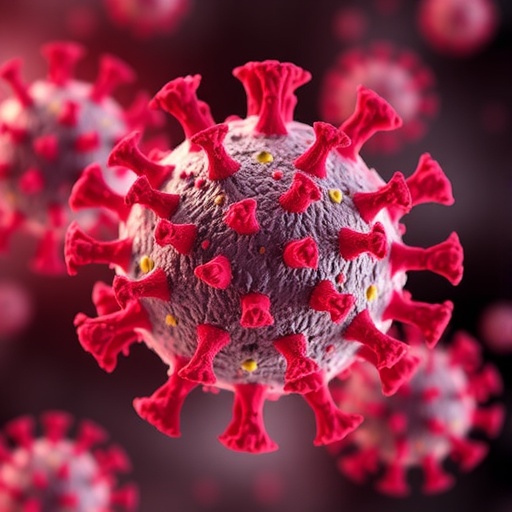In a landmark study poised to redefine the battle against Chikungunya virus (CHIKV), researchers have illuminated the intricate molecular interplay of neutralizing antibodies that effectively disarm this formidable pathogen. The findings, recently published in Nature Communications, harness advanced structural biology to unravel the precise mechanism through which these antibodies intercept the virus, opening promising avenues for therapeutic interventions and vaccine design in the fight against this debilitating mosquito-borne disease.
Chikungunya virus, known for its rapid spread and the severe joint pain it causes, has long posed a public health challenge, especially in tropical and subtropical regions. Despite its global impact, effective antiviral therapeutics and vaccines have remained elusive, underscoring the urgent need for a deeper understanding of immune defense mechanisms against this virus. The present study by Han, Ji, Tian, and colleagues marks a critical step forward by isolating potent neutralizing antibodies from infected subjects and meticulously characterizing their functional capacities.
Central to the research was the use of cryo-electron microscopy and X-ray crystallography techniques to capture high-resolution images of antibody-virus complexes. These technologies revealed how the antibodies bind to specific epitopes on the CHIKV envelope glycoproteins, structural components essential for viral entry into host cells. The antibodies achieve viral neutralization primarily by sterically hindering the interaction sites required for cell attachment and fusion, effectively blocking infection at a molecular gatekeeper level.
The detailed structural elucidation underscored two distinct classes of neutralizing antibodies targeting unique regions of the viral E2 glycoprotein. One class was found to obstruct the receptor-binding domain, thwarting the initial step of host cell recognition. Meanwhile, the second class interfered with the conformational rearrangements necessary for membrane fusion, a crucial process for viral genome delivery into the host cytoplasm. This dual-pronged antibody activity not only halts viral ingress but also significantly reduces the likelihood of viral escape through mutation.
Beyond mechanistic insights, the researchers evaluated the neutralization breadth of these antibodies across various CHIKV strains. Impressively, the antibodies exhibited cross-strain reactivity, indicating their potential as broad-spectrum therapeutics. This property is particularly vital given the genetic diversity of CHIKV, which has complicated vaccine efficacy and necessitated adaptable therapeutic strategies.
The study also highlighted that natural infection induces a diverse antibody response repertoire, with some antibodies demonstrating superior potency and binding affinity. Mapping these epitopes involved sophisticated computational modeling to predict antigenic hot spots, which were then experimentally validated. Such knowledge is instrumental in guiding the rational design of epitope-focused vaccines aimed at eliciting robust and durable immune protection.
From a translational perspective, these findings have significant implications. The molecular blueprints of these neutralizing antibodies could inform the engineering of monoclonal antibodies optimized for therapeutic administration. Moreover, the identified epitopes offer strategic targets for next-generation vaccine candidates that stimulate the immune system to produce similarly effective antibodies in at-risk populations.
Critically, the research addressed potential challenges including antigenic variability and antibody-dependent enhancement (ADE), a phenomenon where suboptimal antibodies exacerbate infection. By focusing on epitopes that mediate potent neutralization without triggering ADE, the study paves the way for safer antibody-based interventions.
Complementing structural analyses, in vitro neutralization assays measured the efficacy of the antibodies in preventing CHIKV infection in cultured cells. Correlating structural data with functional outcomes allowed the team to establish quantitative relationships between binding affinity, epitope specificity, and neutralization potency. These insights are invaluable for screening candidate antibodies in drug development pipelines.
Furthermore, the elucidation of antibody-virus interactions enriches our broader understanding of alphavirus immunobiology. It underscores conserved features within viral fusion machinery that multiple alphaviruses exploit, hinting that therapeutic strategies developed here may also extend to related pathogens. This cross-applicability could significantly enhance global preparedness against emerging viral diseases.
Looking ahead, longitudinal studies tracking antibody durability and protection in vaccinated or previously infected individuals will be essential. The groundwork laid by this research provides a robust platform for such investigations, charting a clear path from molecular discovery to clinical application.
The convergence of cutting-edge structural biology, immunology, and virology exhibited in this study exemplifies the power of interdisciplinary science in tackling complex infectious diseases. As Chikungunya continues to threaten millions worldwide, this breakthrough offers renewed hope for effective medical countermeasures that can alleviate suffering and curb outbreaks.
In summary, the comprehensive characterization of neutralizing antibodies against CHIKV delineated in this study not only enhances our molecular understanding of viral neutralization but also accelerates the development of promising antiviral therapies. Through detailed mechanistic insights and structural revelations, Han, Ji, Tian, and colleagues have charted a course that may soon translate scientific knowledge into lifesaving solutions for communities vulnerable to Chikungunya virus.
Subject of Research: Neutralizing antibodies targeting Chikungunya virus and structural mechanisms underlying their antiviral activity.
Article Title: Neutralizing antibodies against Chikungunya virus and structural elucidation of their mechanism of action.
Article References:
Han, X., Ji, C., Tian, S. et al. Neutralizing antibodies against Chikungunya virus and structural elucidation of their mechanism of action. Nat Commun 16, 9682 (2025). https://doi.org/10.1038/s41467-025-64687-2
Image Credits: AI Generated




